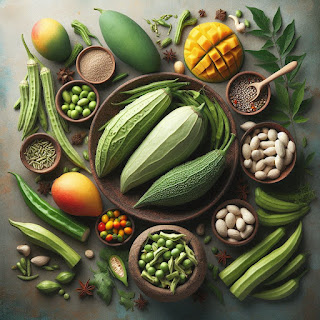Seasonal Foods for the Month of June in India
June marks the beginning of the monsoon season in India, bringing a much-needed respite from the scorching summer heat. The arrival of rain not only rejuvenates the environment but also brings an abundance of seasonal fruits, vegetables, grains, and pulses. Consuming seasonal produce is not only beneficial for health but also supports local farmers and the economy. Here’s a comprehensive guide to the seasonal foods available in India during June.
Grains
Rice:
Varieties: Basmati, Sona Masuri, Ponni
Uses: Rice is a staple in Indian cuisine, used in dishes like biryanis, pulao, idlis, and dosas. The monsoon season is ideal for growing rice as it requires a lot of water.
Bajra (Pearl Millet):
Benefits: Rich in fiber, iron, and protein.
Uses: Commonly used to make rotis, khichdi, and porridges. Bajra is beneficial for digestive health and keeps the body warm during the cooler monsoon months.
Pulses
Moong Dal (Green Gram):
Benefits: High in protein, easy to digest, and versatile.
Uses: Used in soups, dals, khichdi, and sprouted for salads. Moong dal is light on the stomach and perfect for monsoon meals.
Arhar Dal (Pigeon Pea):
Benefits: Rich in protein and fiber.
Uses: Commonly used to make sambar, dals, and stews. It is a staple in Indian households, especially during the rainy season when hearty, warming meals are preferred.
Fruits
Mango:
Varieties: Alphonso, Kesar, Banganapalli, Himsagar
Benefits: Rich in vitamins A and C, antioxidants, and fiber.
Uses: Eaten fresh, used in smoothies, desserts, pickles, and savory dishes. Mangoes are the quintessential fruit of the Indian summer and early monsoon.
Jamun (Indian Blackberry):
Benefits: High in vitamin C, iron, and antioxidants.
Uses: Consumed fresh, used in juices, jams, and desserts. Jamun helps in improving digestion and controlling blood sugar levels.
Lychee:
Benefits: Rich in vitamin C, antioxidants, and potassium.
Uses: Eaten fresh, used in desserts, juices, and salads. Lychees are hydrating and refreshing, making them perfect for the humid weather.
Vegetables
Bhindi (Okra):
Benefits: High in fiber, vitamin C, and folate.
Uses: Used in stir-fries, curries, and as a fried snack. Okra is versatile and easy to cook, making it a monsoon favorite.
Tinda (Indian Round Gourd):
Benefits: Low in calories, high in fiber and vitamins.
Uses: Used in curries, stews, and stuffed vegetable dishes. Tinda is light and nutritious, ideal for the monsoon season.
Bottle Gourd (Lauki):
Benefits: Hydrating, low in calories, and high in vitamins.
Uses: Used in soups, curries, and desserts like halwa. Bottle gourd is soothing for the digestive system and helps in maintaining hydration.
Drumstick (Moringa):
Benefits: Rich in vitamins, minerals, and antioxidants.
Uses: Commonly used in sambar, soups, and curries. Drumstick leaves and pods are both highly nutritious and boost immunity.
Benefits of Eating Seasonal Foods
Nutrient-Rich: Seasonal produce is harvested at its peak, ensuring maximum nutrient content.
Eco-Friendly: Consuming seasonal foods reduces the carbon footprint associated with transporting out-of-season produce.
Cost-Effective: Seasonal fruits and vegetables are abundant and thus cheaper than non-seasonal ones.
Supports Local Farmers: Buying seasonal produce helps local farmers and boosts the local economy.
Incorporating seasonal foods into your diet is a great way to stay healthy and enjoy the natural flavors of the season. June offers a bounty of fresh produce in India, from juicy mangoes and lychees to nutritious pulses and grains. Embrace the monsoon by savoring these seasonal delights and supporting local agriculture.By focusing on these seasonal foods, you can enjoy a diverse and nutritious diet while also contributing to sustainable practices. Whether you're cooking up a comforting dal or indulging in a fresh mango, June's produce has something to offer for everyone.










No comments:
Post a Comment